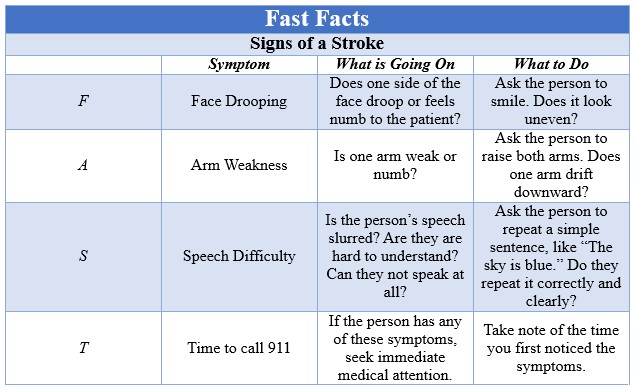What is going on?
You’re having dinner with family and friends when all of a sudden you start slurring your words and can’t move part of your body. What is going on? It could be a number of things, but the biggest concern is that it might be a stroke. Why is this so alarming? What should be done to help you? How can you limit your chances of having a stroke?
.jpg) Definition
Definition
A stroke (or CVA, Cerebrovascular Accident) is when blood carrying oxygen and nutrients to the brain is blocked by either a clot or rupture of a blood vessel. This causes the brain cells that are not receiving the oxygen and nutrients to start to die. Time is of the essence when it comes to getting treatment. The two types of strokes (ischemic-clot and hemorrhagic-bleeding) require very different courses of treatment and are diagnosed by a CT (Computed Tomography) scan or MRI (Magnetic Resonance Imaging).
In ischemic strokes, a clot blocks the blood flow, so the goal of the treatment is to remove the clot. This is accomplished in two ways. By dissolving the clot with a medicine called tPA (tissue plasminogen activator) and/or a mechanical thrombectomy (surgical intervention where doctors physically remove the clot). With tPA, there is a very distinct criteria that patient must meet in order to be eligible to receive the medicine. One large factor is that the medicine must be administered within 3 hours of the start of symptoms. Another significant consideration is the risk of bleeding that is associated with tPA. A mechanical thrombectomy can only be completed on patients who have had tPA without any change in condition and must be done within 6 hours of the onset of symptoms. Sometimes, the symptoms disappear after a little while without any medical intervention. This is called a TIA (Transient Ischemic Attack or “mini stroke”) and should be taken very serious. It is a warning sign that a person is at an increased risk for having a full stroke. It is important to be evaluated at a hospital if this occurs.
In the case of hemorrhagic strokes, they are caused by usually by a weakening in the blood vessel (aneurysm or arteriovenous malformation–AVM) and high blood pressure. When the vessel ruptures, the blood that normally flows through the vessel is now pooling inside the skull. This causes the same effect of the lack of oxygen and nutrients to brain cells further down the vessel from the rupture. For treatment, it is usually preventative if an aneurysm or AVM is found prior to it rupturing. This is done through surgery in which a catheter is inserted in a major artery in an arm or leg, guided to the aneurysm or AVM, and a special coil (or similar device) is put in place to fill the space. The patient is also usually on medication to help control blood pressure. In the event of a rupture, surgery is often required to repair the AVM or place a clip on the aneurysm.
In either type of stroke, it is essential to get the symptomatic person to the hospital for treatment as quickly as possible due to the longer the wait, the more likely chance that the symptoms will be irreversible and the possibility of death increases.
Symptoms
The brain is incredibly complex and controls most bodily functions, so when it is injured by lack of blood flow to certain areas, it can present in various ways. Therefore, it is important to understand all the possible symptoms that could occur. The brain is split into two halves with each controlling the opposite side of the body; for instance, the right side of the brain controls the left side of the body and vice versa. So, this means if a person is having a stroke that affects the right side of the brain, they will most likely have these symptoms: paralysis on the left side of the body, vision problems, quick/inquisitive behavior, and memory loss. Whereas, if the stroke is affecting the left side of the brain, the symptoms will probably be: paralysis on the right side of the body, speech/language problems, slow/cautious behavior, and memory loss. A stroke can occur in the brain stem (which is the central part of the brain that controls basic bodily functions that we do not even have to think about, such as our heart rate or breathing rate). This type of stroke can affect both sides of the brain, therefore, the person can exhibit symptoms of both left and right sided strokes combined. For a quick and easy way to identify if someone might be having a stroke, please refer to Fast Facts.
Prevention
There are multiple risk factors for potentially having a stroke, some of which cannot be changed, such as age, heredity, race, gender, and having a prior CVA, TIA, or heart attack. Other risk factors you have some control over, such as managing the following: high blood pressure, diabetes, high cholesterol, atrial fibrillation (AFib), carotid/peripheral artery disease, and sickle cell disease. Some risk factors you can control are alcohol abuse and drug abuse, but the three key items you have complete control over are cigarette smoking, poor diet, and inactivity. It is vital to reduce your chance at having a stroke to not smoke, eat a healthy diet, and be physically active. As with any lifestyle changes that can impact your health, consult with a physician prior to making them.
Strokes can happen all of a sudden and with the proper intervention provided in a timely manner can make the difference between lifelong devastating consequences and, in some cases, a full recovery. For more information about strokes, please visit the American Stroke Association website at www.strokeassociation.org